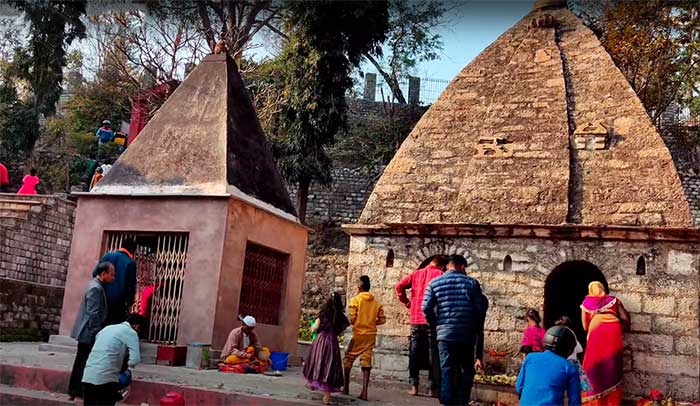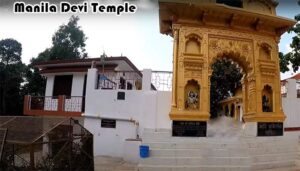The Sitavani Temple is in the Sitavani Forest Reserve, and it’s a great place for tourists. The temple is known for its beautiful architecture, making it interesting for people from all over the world. In the temple area, you can see jackals, wild boars, barking deer, leopards, tigers, elephants, and king cobras. Because of this variety of wildlife, the temple is recognized and protected by the Archaeological Survey of India (ASI).
This temple is devoted to Goddess Sita and is unique because it has idols of Luv and Kush along with a Shivling on the other side. It’s located in Sitavani zone of the Jim Corbett National Park, and being in the Mailani range, it gives visitors a stunning view of the hills and forests around. The temple has water flowing through three channels and a beautiful pond as part of its special design, making it a must-visit place for people who love nature and history.
History of Sitavani Temple
In the old stories, people say that Mother Sita came to the Sitavani forest with her sons Luv and Kush and stayed for a while. To remember this, a temple was built in the Corbett Tiger Reserve, and that’s why the place is called ‘Sitavani,’ meaning Goddess Sita’s Forest. The temple is very old and is quite isolated. A solitary priest resides within the heart of the dense forest and wildlife surroundings. Moreover, the temple features a dedicated water source that dispenses warm water.
Entry fee & Timings
Because this area is a forest zone, hence it is imperative to inquire about the operating hours directly from the forest department. Additionally, obtaining an entry pass for your vehicle or arranging for a gypsy is necessary, and the associated formalities can be facilitated through the latter option.
Why this temple famous among peoples?
Sitavani Temple is famous for its history and unique design. People value it for its spiritual importance because it’s dedicated to Goddess Sita, who is said to have stayed there during her exile before the Agnipariksha. The temple is located where Maharishi Valmiki had his hermitage.
You can find old things like amlaka stones, a Ganesha sculpture without a head, a doorjamb, and carved slabs near the current temple, showing how old the place is. But it’s important to know that the temple standing now was built later, not in the ancient times. These are the reasons why this temple is renowned among both locals and tourists alike.
What one can see in Sitavani Temple?
These are the interesting things which one can discover in Sitavani Temple.
Amlaka Stones: Find old amlaka stones, giving a peek into the history of the temple.
Headless Ganesha Sculpture: See a special sculpture of Lord Ganesha without a head. It shows how skilled the artists were.
Doorjamb: Look at the doorjamb, a part of the temple that adds to its cultural and historical importance.
Carved Slabs: Enjoy the beauty of carefully carved slabs, showing the art from the past.
Vibes of Divine: Feel the peaceful and spiritual atmosphere in the temple. It’s a special place where you can connect with the divine energy.
Nearyby attractions
You can discover some amazing places near Sitavani Temple.
Garjiya Temple (37 KM): Go on an adventure to Garjiya Devi Temple, which is 37 kilometers away. This special place offers a spiritual experience with its cultural and beautiful architecture.
Shri Hanuman Dham Temple Choi (29 KM): Experience the peaceful and spiritual atmosphere at Shri Hanuman Dham Temple Choi, just 29 kilometers from Sitavani Temple. It’s a well-known temple where you can feel a sense of serenity and devotion.
Corbett Waterfalls (31 KM): Enjoy a scenic 31-kilometer drive to reach the stunning Corbett Waterfalls. Immerse yourself in the natural beauty and calming sounds of the flowing water in this picturesque spot.
Jim Corbett Museum (33 KM): Dive into the history and wildlife heritage at the Jim Corbett Museum, located 33 kilometers away. Explore exhibits that tell stories about the fascinating plants and animals in the region.
How to reach Sitavani Temple
Latitude- 29.40°N, Longitude-79.12°E
Sitavani Temple is located within the premises of Jim Corbett National Park, and convenient access is available through multiple modes of transportation, including buses, private cars, trains, and flights.
The closest bus stand and railway station are in Ramnagar, with Sitavani Temple situated approximately 24 kilometers away from the town. For air travel, Pant Nagar Airport serves as the nearest airport to reach Jim Corbett National Park.
Sitavani Temple : A Spiritual Retreat Tucked Deep in the Forest
On one of our unplanned days near Jim Corbett National Park, we stumbled upon a hidden gem that felt like stepping into another world Sitavani Temple, nestled deep inside the Sitavani Forest Zone. And honestly, it was one of the most peaceful and grounding experiences of our trip.
The Journey is Half the Experience
Reaching the temple itself was an adventure. The road is not your average smooth drive it’s a rugged, bumpy path that takes you through dense forest trails and dirt tracks. If you have an SUV or book a gypsy safari vehicle, you’re in for a thrilling ride. But we also saw some adventurous families make it in small hatchbacks like i10s. Either way, the drive is scenic and wild, setting the tone for the tranquility that awaits.
A Temple of Stories and Solitude
Once you arrive, the charm of the place takes over instantly. The temple complex is small and ancient, yet filled with immense spiritual energy. At the heart of it is a temple dedicated to Goddess Sita, believed by locals to be the spot where she lived in Valmiki’s Ashram and gave birth to Luv and Kush. The mythology, the silence, and the forested backdrop come together to create a sense of reverence and stillness.
Don’t miss exploring the other shrines within the complex you’ll find old rock-carved Shivlings, Nandi, Lord Hanuman idols, and even a beautiful Shiva temple perched just above the main one. The whole setting feels like it’s been frozen in time, holding stories in every stone.
Nature at Its Purest (Almost)
A small cool stream flows through the complex, and dipping your feet into its fresh water is the perfect relief on a hot day. There’s also a quaint little pond full of tiny fishes, which adds to the soothing vibes of the place. Bird calls, rustling trees, and the occasional monkey chatter are all you’ll hear no honking, no crowds, no chaos.
But here’s where the magic gets a little marred. Despite being located inside a protected forest, there’s a disturbing amount of plastic waste juice bottles, wrappers, and discarded items scattered around. It’s disheartening, especially because garbage bags are actually provided at the forest entry point. While the forest trail remains untouched and pristine, the temple area needs better maintenance and stricter oversight.
A Peaceful Detour from the Usual Safari
Interestingly, many visitors (like us) end up here when Jim Corbett safari slots are full, but honestly, Sitavani deserves a visit regardless. You won’t find wild animals easily in this zone, but what you will find is a deep connection to mythology, peace, and nature. Just be mindful of monkeys, especially near the prasad and your bags they’re quick and curious.
Final Thoughts:
Sitavani Temple is not a flashy tourist spot it’s quiet, raw, and deeply spiritual. If you’re someone who values mythology, loves nature, or just wants to escape the crowds and noise, this is your kind of place. It’s also a reminder of the many unsung places associated with Sita, who often remains in the background in mainstream narratives.
A little more attention from the authorities could make this site truly shine. But until then, if you do visit, travel responsibly, carry your own waste bag, and help keep this divine forest sanctuary clean.




